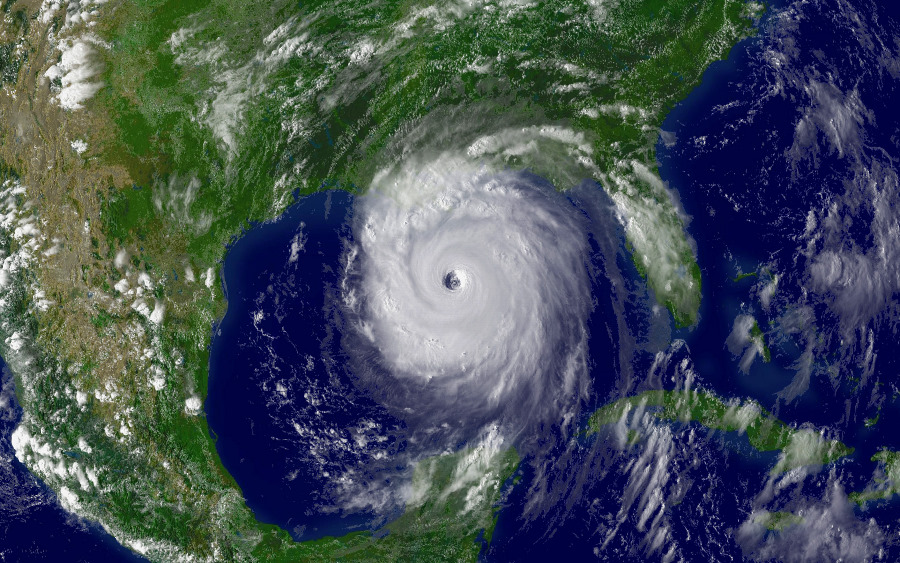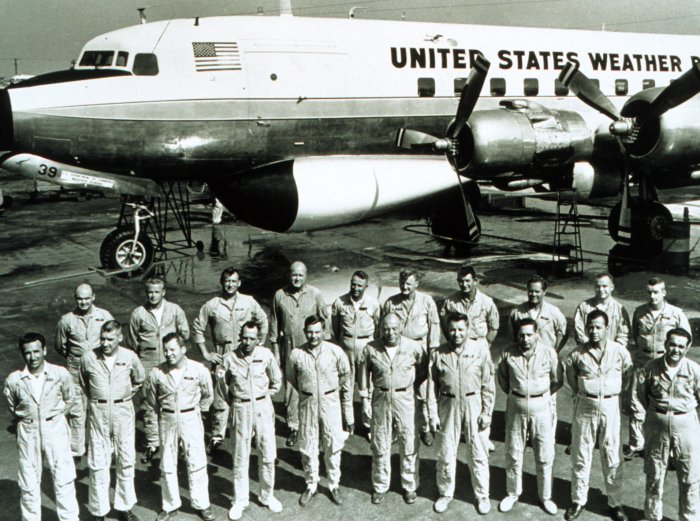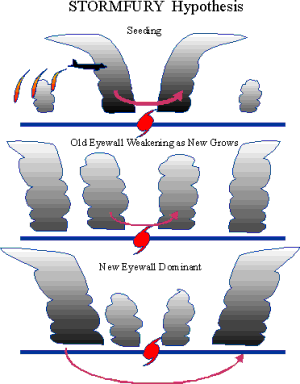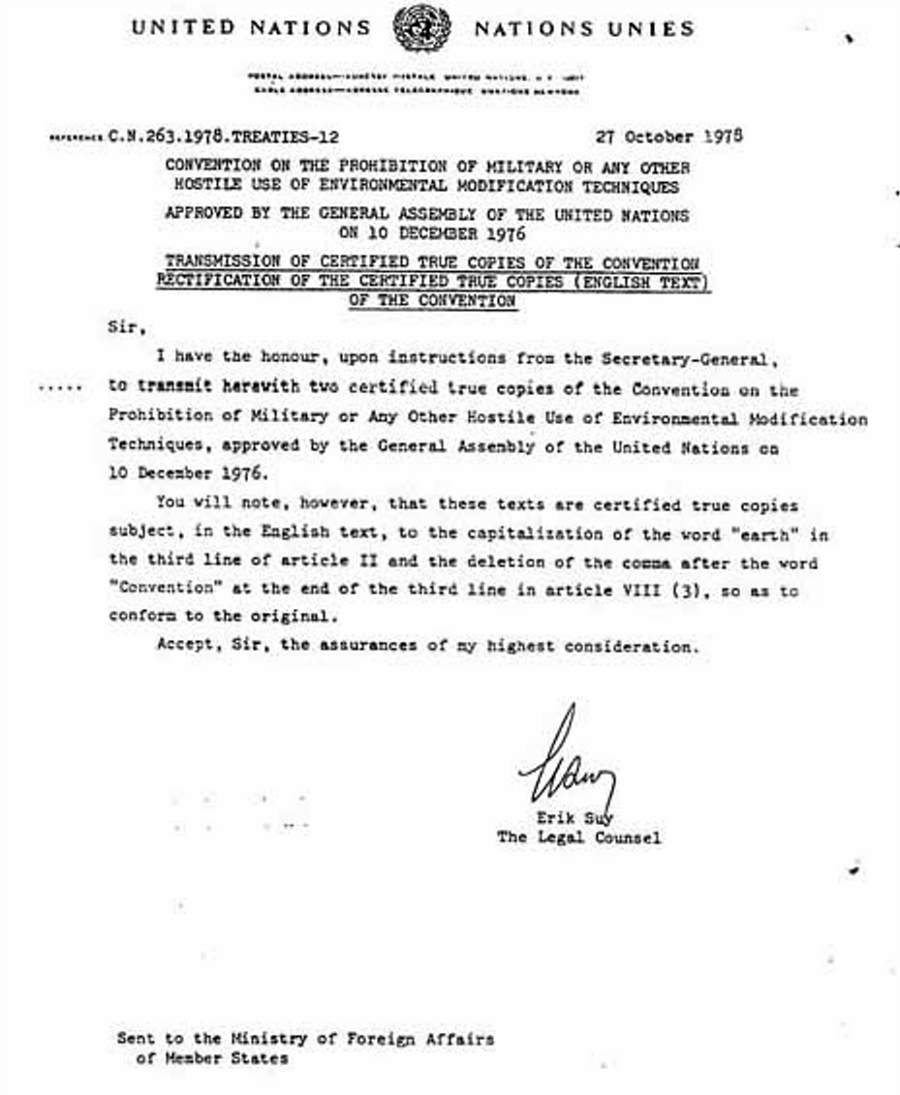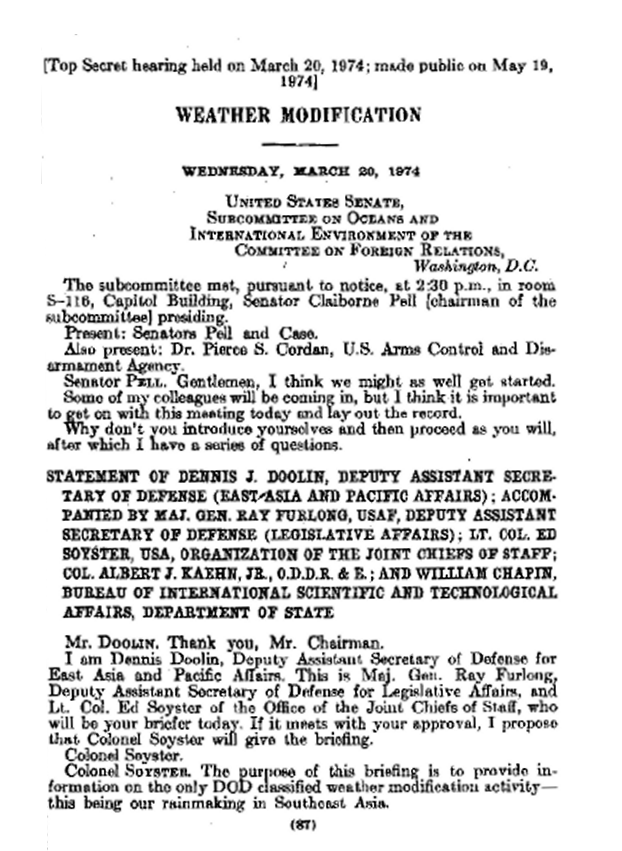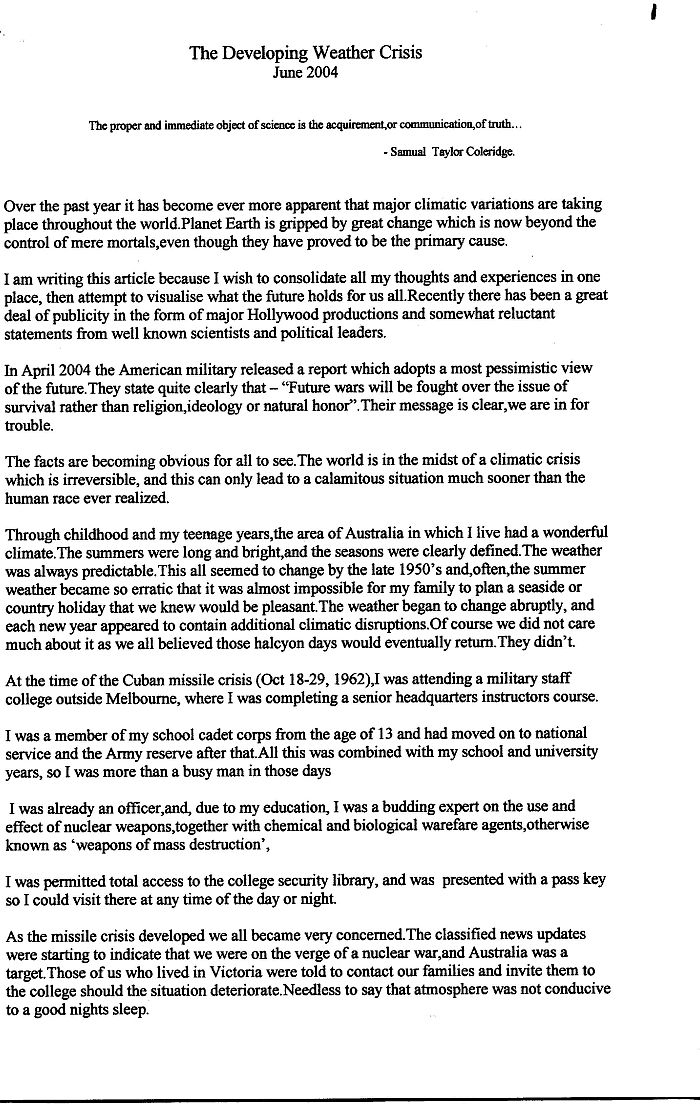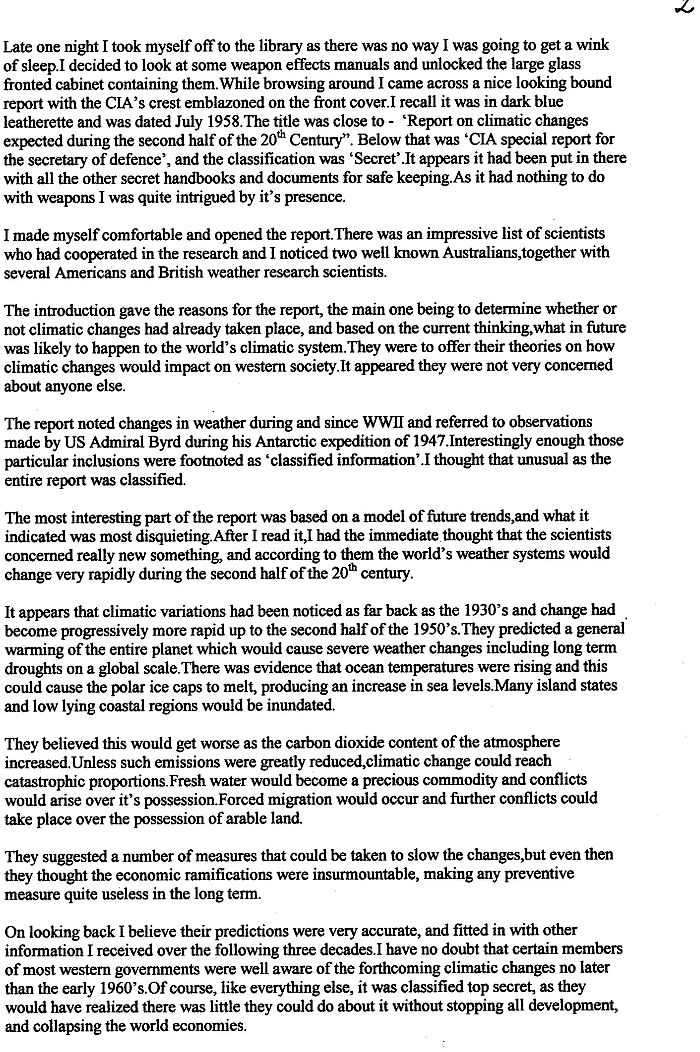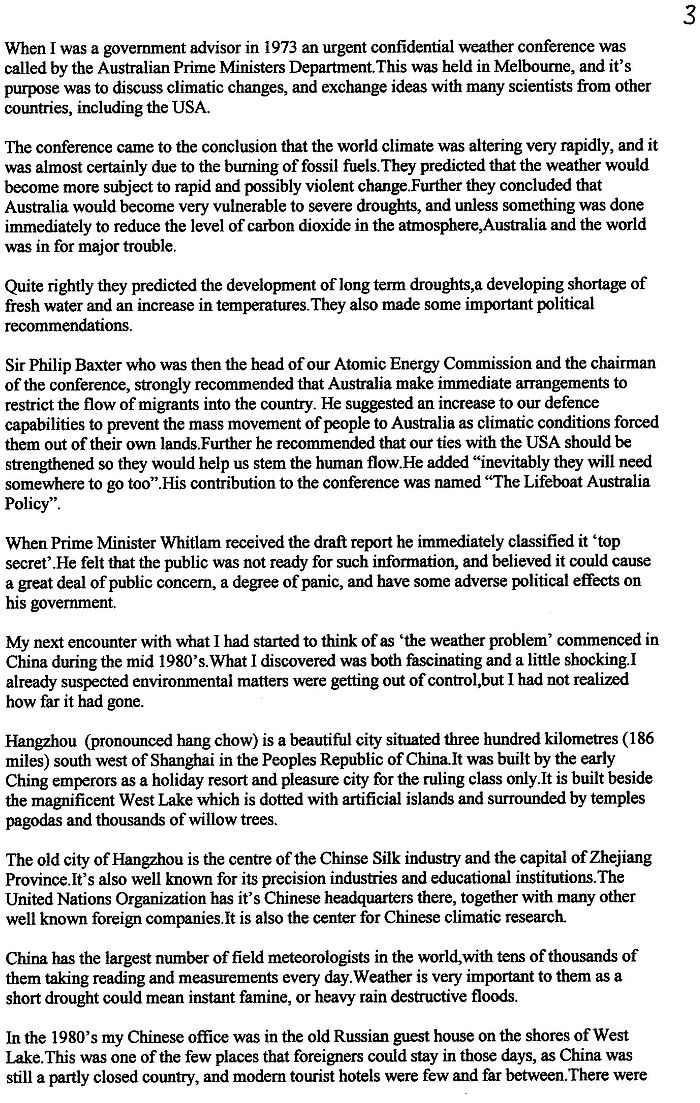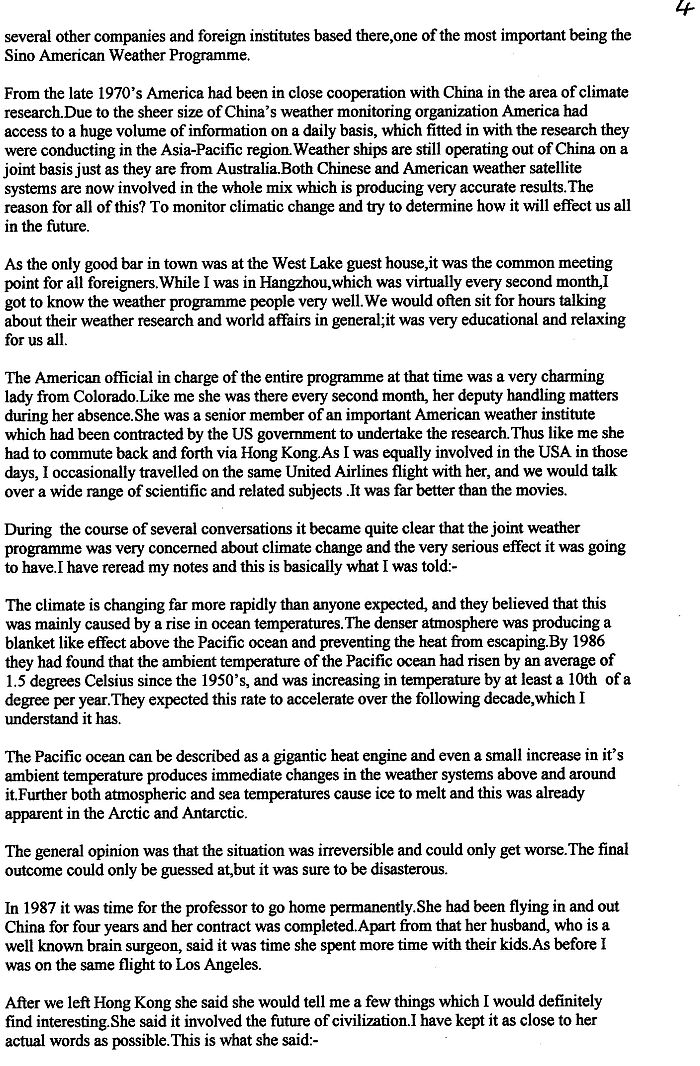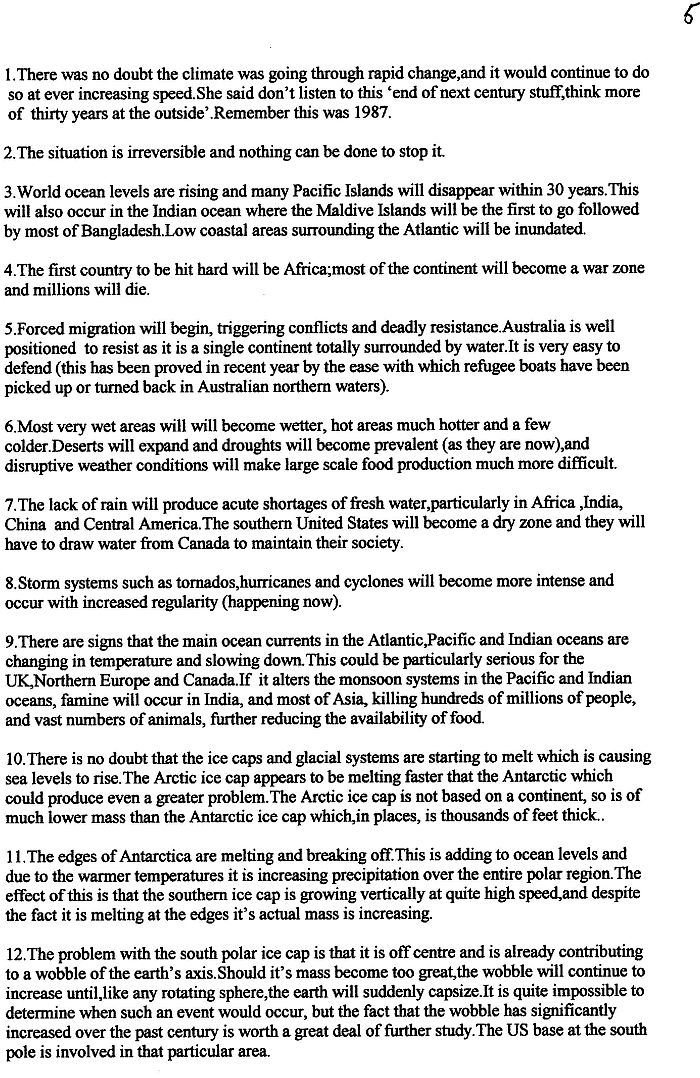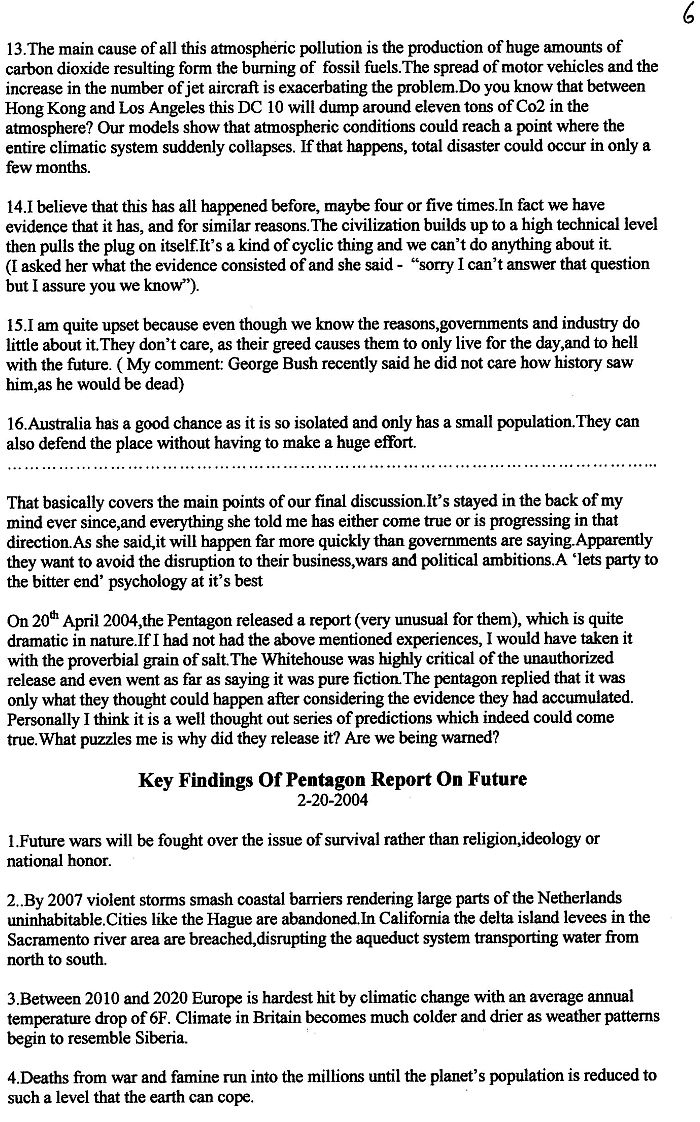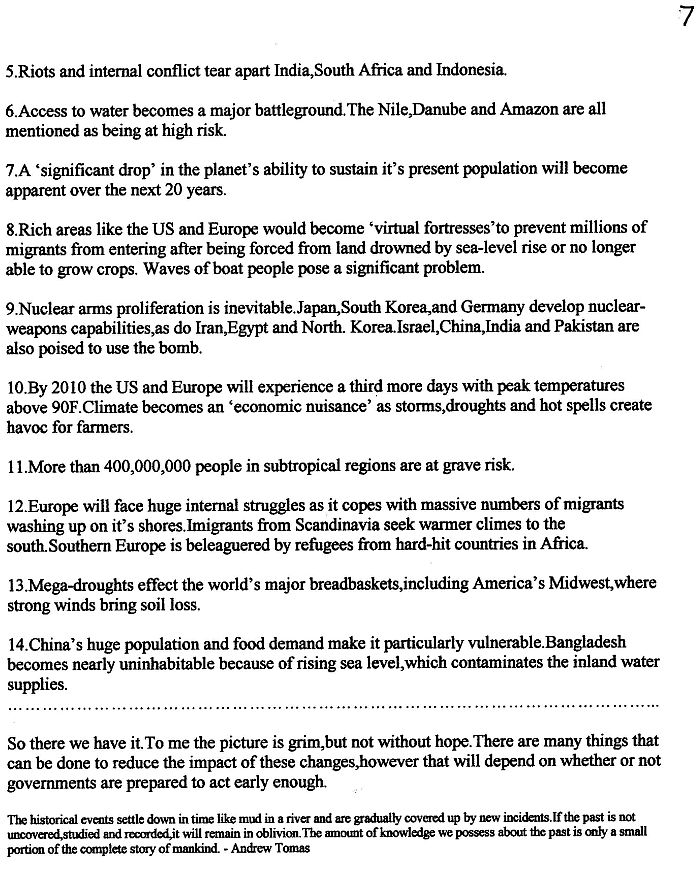|
Weather Warfare
|
Project Stormfury
..
Hurricane Katrina-08-28-2005
Category Five

Project Stormfury
was an ambitious experimental program of research on hurricane modification
carried out between 1962 and 1983. The proposed modification technique
involved artificial stimulation of convection outside the eyewall through
seeding with silver iodide. The invigorated convection, it was argued,
would compete with the original eyewall, lead to reformation of the eyewall
at larger radius, and thus, through partial conservation of angular momentum,
produce a decrease in the strongest winds.
Since a hurricane's destructive potential increases
rapidly as its strongest winds become stronger, a reduction as small as
10% would have been worthwhile. Modification was attempted in four hurricanes
on eight different days. On four of these days, the winds decreased by
between 10 and 30%, The lack of response on the other days was interpreted
to be the result of faulty execution of the seeding or of poorly selected
subjects.
These promising results came into question in the mid-1980s
because observations in unmodified hurricanes indicated:
1. That cloud seeding had little prospect
of success because hurricanes contained too much natural ice and too little
supercooled water.
2. That the positive results inferred
from the seeding experiments in the 1960s stemmed from inability to discriminate
between the expected results of human intervention and the natural behavior
of hurricanes.
Reference
Willoughby, H. E., D. P. Jorgensen, R. A. Black, and
S. L. Rosenthal, 1985: Project STORMFURY, A Scientific Chronicle, 1962-1983,
Bull. Amer. Meteor. Soc., 66, 505-514.
National Oceanic and Atmosphere Administration (NOAA)
Office of Oceanic and Atmospheric Research
Atlantic oceanographic and Meteorological Laboratory
(AOML)
SOURCE: http://www.aoml.noaa.gov/hrd/hrd_sub/sfury.html |
OUR MISSION
..
Credit: United States Air
Force - Douglas DC-6
1966 photo of the crew and personnel
of Project Stormfury
Hurricane Modification?
Can human intervention diminish the force of a hurricane?
From the mid-1960s through the early 1980s NOAA actively pursued Project
STORMFURY, a program of experimental hurricane modification. The general
strategy was to reduce the intensity of the storm by cloud seeding. The
seeding, it was argued, would stimulate the formation of a new eyewall
that would surround the existing eyewall. The new eyewall would contract,
strangling the old eyewall and reducing the intensity of the hurricane.
However, research carried out at AOML showed clearly that these "concentric
eyewalls" happened often in unmodified hurricanes, thus casting doubt on
the seemingly positive results of seeding in earlier experimentation. Hurricane
Luis provides an example of this behavior. Moreover, observations showed
that hurricanes contain little of the supercooled water necessary for cloud
seeding to work.
The American Meteorological Society policy statement
on planned and inadvertent weather modification, dated October 2, 1998,
indicates, "There is no sound physical hypothesis for the modification
of hurricanes, tornadoes, or damaging winds in general, and no related
scientific experimentation has been conducted in the past 20 years." In
the absence of a sound hypothesis, no Federal agencies are presently doing,
or planning, research on hurricane modification.
Some techniques besides seeding clouds that have been
considered over the years include: cooling the ocean with cryogenic material
or icebergs, retardation of surface evaporation with monomolecular films,
changing the radiational balance in the hurricane environment by absorption
of sunlight with carbon black, blowing the hurricane apart with hydrogen
bombs, injecting air into the center with a huge maneuverable tube to raise
the central pressure, and blowing the storm away from land with windmills.
As carefully reasoned as some of these suggestions are, they all fall short
of the mark because they fail to appreciate the size and power of tropical
cyclones. For example, when hurricane Andrew struck South Florida in 1992,
the eye and eyewall devastated a swath 20 miles wide. The heat energy released
around the eye was 5,000 times the combined heat and electrical power generation
of the Turkey Point nuclear power plant over which the eye passed. Better
building codes, wiser land use, and more accurate forecasts seem prosaic
compared with environmental mega engineering but they are a great deal
cheaper and have overwhelmingly favorable cost-benefit ratios.
SOURCE: http://www.aoml.noaa.gov/hrd/hrd_sub/modification.html
Related Links:
|
NOAA’S NATIONAL WEATHER
SERVICE
AWARDS $300 MILLION AWIPS CONTRACT
TO RAYTHEON
The National Oceanic and Atmospheric
Administration’s National Weather Service has awarded a performance-based
contract to Raytheon Technical Services Company LLC for the operations
and maintenance, optional product improvements, and software maintenance
and support of the Advanced Weather Interactive Processing System (AWIPS).
The contract is for five years,
with five one-year award terms for a potential of a 10-year contract. The
contract has the potential value of approximately $300 million over a 10-year
contract life.
AWIPS is the computerized system
that processes and overlays multiple data sources to allow local Weather
Forecast Offices and River Forecast Centers to generate weather and water
forecasts and warnings. It is a cornerstone technology of the modernized
National Weather Service.
AWIPS continually evolves to
accommodate new science and technology to meet National Weather Service,
NOAA and Department of Commerce strategic goals. This contract represents
a new phase in the operation and maintenance of AWIPS, increasing system
performance and functionality and improving forecasts and warning timeliness
to support the National Weather Service mission.
NOAA’s National Weather Service
is the primary source of weather data, forecasts and warnings for the United
States and its territories. NOAA’s National Weather Service operates the
most advanced weather and flood warning and forecast system in the world,
helping to protect lives and property and enhance the national economy.
The National Oceanic and Atmospheric
Administration, an agency of the U.S. Commerce Department, is dedicated
to enhancing economic security and national safety through the prediction
and research of weather and climate-related events and providing environmental
stewardship of our nation’s coastal and marine resources. Through the emerging
Global Earth Observation System of Systems (GEOSS), NOAA is working with
its federal partners and nearly 60 countries to develop a global monitoring
network that is as integrated as the planet it observes.
On the Web:
NOAA: http://www.noaa.gov
NOAA’s National Weather Service:
http://www.nws.noaa.gov
SOURCE: http://www.publicaffairs.noaa.gov/releases2005/aug05/noaa05-098.html |
| Project Stormfury
Project Stormfury was an attempt to weaken tropical
cyclones by flying aircraft into them and seeding with silver iodide. The
project was run by the United States Government from 1962 to 1983.
The hypothesis was that the silver iodide would cause
supercooled water in the storm to freeze, disrupting the inner structure
of the hurricane. This led to the seeding of several Atlantic hurricanes.
However, it was later shown that this hypothesis was incorrect. In reality,
it was determined most hurricanes do not contain enough supercooled water
for cloud seeding to be effective. Additionally, researchers found that
unseeded hurricanes often undergo the same structural changes that were
expected from seeded hurricanes. This finding called Stormfury's successes
into question, as the changes reported now had a natural explanation.
The last experimental flight was flown in 1971, due
to a lack of candidate storms and a changeover in NOAA's fleet. More than
a decade after the last modification experiment, Project Stormfury was
officially cancelled. Although a failure in its goal of reducing the destructiveness
of hurricanes, Project Stormfury was not without merit. The observational
data and storm lifecycle research generated by Stormfury helped improve
meteorologists'
ability to forecast the movement and intensity of future hurricanes.
..
Credit: U.S. National
Oceanic and Atmospheric Administration
The Hypothesis
Cloud seeding was first attempted by Vincent Schaefer
and Irving Langmuir. After witnessing the artificial creation of ice crystals,
Langmuir became an enthusiastic proponent of weather modification.[1]
Schaefer found that when he dumped crushed dry ice into a cloud, precipitation
in the form of snow resulted.[2]
With regard to hurricanes, it was hypothesized that
by seeding the area around the eyewall with silver iodide, latent heat
would be released. This would promote the formation of a new eyewall. As
this new eyewall was larger than the old eyewall, the winds of the tropical
cyclone would be weaker due to a reduced pressure gradient.[3]
Even a small reduction in the speed of a hurricane's winds would be beneficial;
as the damage potential of a hurricane increased exponentially with its
winds,[4]
a slight lowering of wind velocity would have a large reduction in potential
destructiveness.[4]
Due to Langmuir's efforts, and the research of Schaefer
at General Electric, the concept of using cloud seeding to weaken hurricanes
gathered momentum. Indeed, Schaefer had caused a major snowstorm on December
20, 1946 by seeding a cloud.[2]
This caused GE to drop out for legal reasons. Schaefer and Langmuir assisted
the U.S. military as advisors for Project Cirrus, the first large study
of cloud physics and weather modification. Its most important goal was
to try and weaken hurricanes.[5]
Legacy
In the sense of weakening hurricanes to reduce their
destructiveness, Project Stormfury was a complete failure because it did
not distinguish between natural phenomena in tropical cyclones and the
impact of human intervention.[27]
Millions of dollars had been spent trying to do the impossible. In the
end, "[Project] STORMFURY had two fatal flaws: it was neither microphysically
nor statistically feasible."[29]
In addition, Stormfury had been a primary generator
of funding for the Hurricane Research Division. While the project was operational,
the HRD's budget had been around $4 million (1975 USD), with a staff of
approximately 100 people.[30]
Today, the HRD employs 30 people and has a budget of roughly $2.6 million
each year.[31]
However, Project Stormfury had positive results as
well. Knowledge gained during flights proved invaluable in debunking its
hypotheses.[31]
Other science resulted in a greater understanding of tropical cyclones.
In addition, the Lockheed P-3's were perfectly suitable for gathering data
on tropical cyclones, allowing improved forecasting of these monstrous
storms.[31]Those
planes are still used by the NOAA today.[32]
Related Links:
-
Weather
Modification Association
-
Weather
Modification - Weather Control
-
Testimony
of Dr. Tom DeFelice (Past President, Weather Modification Association)
in support of Weather Modification Operations and Research Board - PDF
-
Weather
Modification Operations and Research Board
-
Weather
Modification Operations and Research Board (passed Oct.2005) - in
corporate cooperation with BAE Systems (HAARP apparatus & facility
owner) and Raytheon Corporation (HAARP patent owner)
-
Eastlund
Scientific Enterprises - The established corporation of Bernard
Eastlund, the inventor of the fusion torch, patents used for the HAARP,
and the weather-modifying "Thunderstorm Solar-Powered Satellite" system.
-
Simulations
of ELF radiation generated by heating the high-latitude D- region
- Some work is done by The United States Navy using ELF: Simulations of
ELF radiation generated by heating the high-latitude D- region. (This work
is supported by the Office of Naval Research and, in part, by a grant of
HPC time from the DoD High Performance Computing Center at the Army Research
Laboratory, Aberdeen Proving Ground)
-
High
Frequency Active Auroral Research Program
(HAARP)
-
HARRP
Animated Gif
-
Bernard
Eastlund - Eastlund is one of the patent holders (US Patent #4,686,605)
that led to the development of the High Frequency Active Auroral Research
Program HAARP which has been sensationalized in many books as a weapon
with the potential to destroy the world by creating a death ray and altering
weather patterns.
-
Montana
Legislature - 2005 -HOUSE BILL NO. 399; A bill for an act entitled:
-
"AN ACT PROVIDING THAT A WEATHER MODIFICATION OPERATION
MAY NOT START BEFORE NOVEMBER 1 OR END AFTER MARCH 15; EXEMPTING WEATHER
MODIFICATION FROM THE REQUIREMENTS OF THE MONTANA ENVIRONMENT POLICY ACT
AND FROM ENVIRONMENTAL IMPACT STATEMENTS; REQUIRING PUBLIC NOTICE OF INTENTION
TO CONDUCT WEATHER MODIFICATION ACTIVITIES; ELIMINATING PUBLIC HEARINGS,
AND PERMIT FEES, AND PROOF OF FINANCIAL RESPONSIBILITY BY AN APPLICANT;
AMENDING SECTIONS 85-3-101, 85-3-201, 85-3-204, 85-3-210, 85-3-211, 85-3-213,
85-3-214, 85-3-301, AND 85-3-302, MCA; REPEALING SECTIONS 85-3-102, 85-3-202,
85-3-206, 85-3-207, 85-3-208, 85-3-211, AND 85-3-212, MCA; AND PROVIDING
AN IMMEDIATE EFFECTIVE DATE."
-
109th
Congress S. 517: Weather Modification Research and Technology Transfer
Authorization Act of 2005
-
Hail
Cannon
-
Beijing
Weather Modification Office
-
Space
Preservation Act
|
Cloud seeding for rain
Cloud seeding is a common technique intended to trigger
rain, but evidence on its effectiveness is mixed. Critics generally contend
that claimed successes occur in conditions which were going to rain anyway.
It is used in several different countries, including the United States,
the People's Republic of China, and Russia. In the People's Republic of
China there is a perceived dependency upon it in dry regions, which believe
they are increasing annual rainfall by firing silver iodide rockets into
the sky where rain is desired. In the United States, dry ice or silver
iodide may be injected into a cloud by aircraft, or from the ground, in
an attempt to increase rainfall; some companies are dedicated to this form
of weather modification.
Ionospheric Experiments
HIPAS has several diverse experimental facilities:
a 1-megawatt rf transmitter to produce ELF/VLF (Extremely Low Frequency
and Very Low Frequency) electromagnetic (EM) generation by the absorption
of radio frequency (rf) power in the arctic ionosphere including ion cyclotron
excitation; a 100 kW rf plasma torch used in research on the destruction
of hazardous waste; a 2.7 m liquid mirror telescope used with one of several
lasers for ionospheric stimulation and measurement; an Incoherent Scatter
Radar (a new project using 88 ft. diameter antenna at NOAA Gilmore Creek
site 34 km SW of HIPAS as the receiving antenna with the transmitter at
HIPAS). HIPAS is in the process of adding a very high power (terawatt)
laser (recently obtained from LLNL) to perform laser breakdown experiments
in the ionosphere. Two Diesel electric generators (1500 HP 4160 V, 3-phase,
1.2 MVA each) are used to power the experiments. There are a number of
computers (PC's ) on site, and a high-speed data line to UAF is available.
While these experiments are useful in measuring the properties of the ionosphere,
they produce insufficient amounts of energy to modify it in any significant
way.
Atmospheric Ionization Research Association Incorporated
in 2007 in Australia began reworking Jack Toyers machine principals (http://video.google.com.au/videoplay?docid=-9102682294862253229)
with operations in regional Queensland Chincilla 2006, Kilcoy 2006, Dalby
2007, Sapphire 2007, Calliope 2007. New South Wales Casino 2006-2008,Lismore
2006-2008 Bourke 2007. Arizona Phoenix 2007-2008, Death Valley 2007 December
2007 dedication to Jack Toyer,Lao and Dr Walter Russells work in Virginia
at Swannonoa Palace estate operating in USA , Mobile to travel to sites
with a great deal of Success within the Target Area's this Science Phenomena
of Rain from Blue Skies and Many other Videos on Google(http://www.youtube.com/watch?v=b-8sVWfmWb8)
China
For the 2008 Olympics, the Chinese have set aside 30
airplanes, 4,000 rocket launchers, and 7,000 anti-aircraft guns to stop
rain. The Chinese plan to shoot various chemicals into any threatening
clouds to shrink rain drops before they reach the stadium.[18]
Other References
-
^ Homer, The
Odyssey, book 10.
-
^ Sir James
Frazer, The
Golden Bough, ch. 5 (abridged edition), "The Magical Control of
Rain"
-
^ Smout, T. C. A
History of the Scottish People 1560-1830, pp 184 - 192
-
^ Adam
of Bremen and Ole
Worm are quoted as maintaining this in Grillot de Givry's Witchcraft,
Magic and Alchemy (Frederick Publications, 1954).
-
^ Frazer, supra.
-
^ abhttp://environment.newscientist.com/article/dn7995.html
- Alamaro proposal and energy critique
-
^ Moshe
Alamaro's brief bio
-
^ http://www.newscientist.com/article.ns?id=dn7726
- Chorin proposal
-
^ Kerry
Emanuel's Homepage
-
^ Could
humans tackle hurricanes? - earth - 14 September 2005 - New Scientist Environment
-
^ Oil
on troubled waters may stop hurricanes - earth - 25 July 2005 - New Scientist
-
^ Anti-hurricane
invention worth pursuing. Murdock, Deroy. Scripps Howard News Service.
22 Oct 2005.
-
^ Environmental
Modification Convention
-
^ "Convention
on the Prohibition of Military or Any Other Hostile Use of Environmental
Modification Techniques", United
States Department of State. Retrieved on 2007-09-28
-
^ S.
517 [109th]: Weather Modification Research and Development Policy Authorization
Act of 2005 (GovTrack.us)
-
^ H.R.
2995 [109th]: Weather Modification Research and Technology Transfer Authorization
Act of 2005 (GovTrack.us)
-
^ Hoffman,
R, "Controlling Hurricanes," Scientific American, Oct 2004.
-
^ Demick,
Barbara, "China plans to halt rain for Olympics," Los Angeles Times,
January 2008.
-
^ COHEN
ADDRESS 4/28 AT CONFERENCE ON TERRORISM Terrorism, Weapons of Mass Destruction,
and U.S. Strategy Sam Nunn Policy Forum April 28, 1997 University of Georgia,
Athens, Georgia
SOURCE: Wikipedia
|
Weather Modification Patents
-
Process for weather control, H. M. Brandau, U.S.
Patent 2,756,097
-
Weather control by artificial means, Heinz W. Kasemir,
U.S.
Patent 3,284,005
-
Cloud formation and subsequent moisture precipitation,
U.S.
Patent 3,409,220
-
System and method for irradiation of planet surface areas,
Aurthur G. Buckingham, U.S.
Patent 3,564,253
-
Weather modification method, Knollenberg, U.S.
Patent 3,613,992
-
Combustible compositions for generating aerosols, particularly
suitable for cloud modification and weather control and aerosolization
process, Consiglio Nazionale delle Richerche, U.S.
Patent 3,630,950
-
Method and apparatus for altering a region in the earth's
atmosphere, ionosphere, and/or magnetosphere, J. Eastlund, U.S.
Patent 4,686,605
-
Method and composition for precipitation of atmospheric
water, Slavko Mentus, U.S.
Patent 5,360,162
-
Use of artificial satellites in earth orbits adaptively
to modify the effect that solar radiation would otherwise have on earth's
weather, Franklin Y. K. Chen, U.S.
Patent 5,762,298
-
Weather modification by artificial satellites, Franklin
Y. K. Chen, U.S.
Patent 5,984,239
Combustible compositions for generating aerosols,
particularly suitable for cloud modification and weather control and aerosolization
process, Consiglio Nazionale delle Richerche, U.S.
Patent RE29,142
SOURCE: Wikipedia
|
Weather Warfare Treaty
United Nations
October 27, 1978
..
|
Weather Modification Paper
Transcript of the US Senate
Hearing on Weather Modification of March 20, 1974
..
PDF
Format Briefing Report: Project Popeye
|
The Developing Weather Crisis
by Andrew Tomas June 2004
..
..
..
..
..
..
..
|
| FAIR USE NOTICE: This page contains copyrighted
material the use of which has not been specifically authorized by the copyright
owner. Pegasus Research Consortium distributes this material without profit
to those who have expressed a prior interest in receiving the included
information for research and educational purposes. We believe this constitutes
a fair use of any such copyrighted material as provided for in 17 U.S.C
§ 107. If you wish to use copyrighted material from this site for
purposes of your own that go beyond fair use, you must obtain permission
from the copyright owner. |
|
~ MENU ~
|
